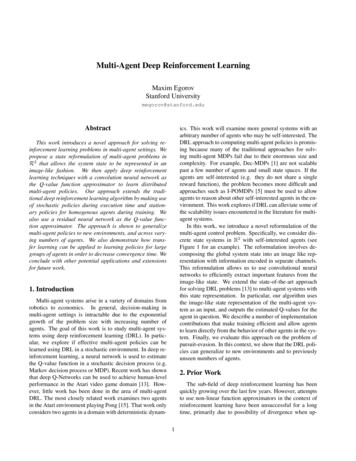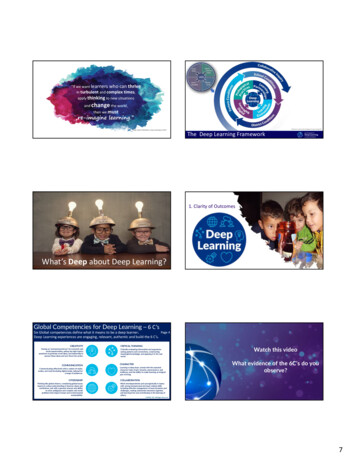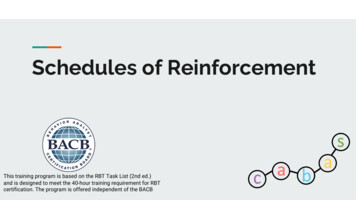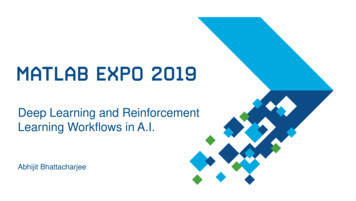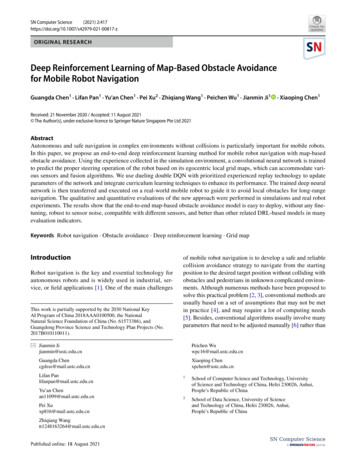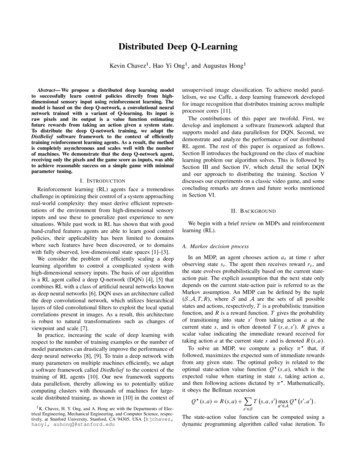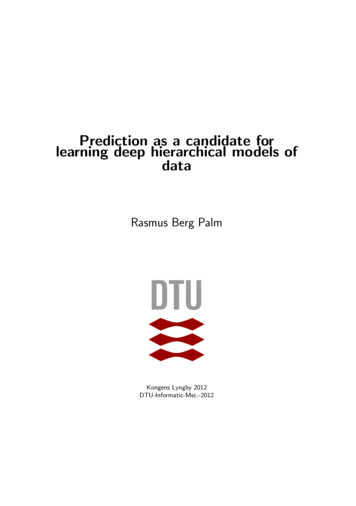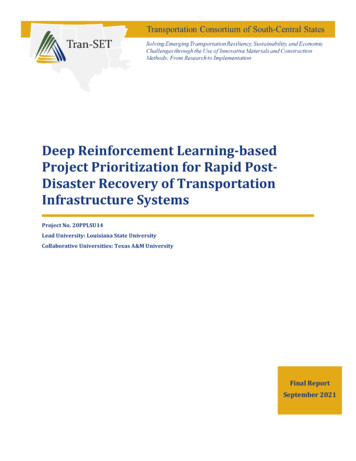
Transcription
Deep Reinforcement Learning-basedProject Prioritization for Rapid PostDisaster Recovery of TransportationInfrastructure SystemsProject No. 20PPLSU14Lead University: Louisiana State UniversityCollaborative Universities: Texas A&M UniversityFinal ReportSeptember 2021
DisclaimerThe contents of this report reflect the views of the authors, who are responsible for the factsand the accuracy of the information presented herein. This document is disseminated in theinterest of information exchange. The report is funded, partially or entirely, by a grant from theU.S. Department of Transportation’s University Transportation Centers Program. However,the U.S. Government assumes no liability for the contents or use thereof.AcknowledgementsThe research team would like to thank you the Project Review Committee members for theirinsightful suggestions and feedback.i
TECHNICAL DOCUMENTATION PAGE1. Project No.2. Government Accession No.20PPLSU144. Title and SubtitleDeep Reinforcement Learning-based Project Prioritization for RapidPost-Disaster Recovery of Transportation Infrastructure Systems3. Recipient's Catalog No.5. Report DateSeptember 20216. Performing Organization Code7. Author(s)PI: Yong-Cheol Lee https://orcid.org/0000-0002-0040-0894PI: Kunhee Choi https://orcid.org/0000-0002-0184-2977Post-Doc: Pedram Ghannad https://orcid.org/0000-0002-5279-05489. Performing Organization Name and AddressTransportation Consortium of South-Central States (Tran-SET)University Transportation Center for Region 63319 Patrick F. Taylor Hall, Louisiana State University, BatonRouge, LA 7080312. Sponsoring Agency Name and AddressUnited States of AmericaDepartment of TransportationResearch and Innovative Technology Administration8. Performing Organization Report No.10. Work Unit No. (TRAIS)11. Contract or Grant No.69A355174710613. Type of Report and Period CoveredFinal Research ReportAugust 2020 – August 202114. Sponsoring Agency Code15. Supplementary NotesReport uploaded and accessible at Tran-SET's website (http://transet.lsu.edu/).16. AbstractAmong various natural hazards that threaten transportation infrastructure, flooding represents a major hazard in Region6's states to roadways as it challenges their design, operation, efficiency, and safety. The catastrophic flooding disasterevent generally leads to massive obstruction of traffic, direct damage to highway/bridge structures/pavement, andindirect damages to economic activities and regional communities that may cause loss of many lives. After disastersstrike, reconstruction and maintenance of an enormous number of damaged transportation infrastructure systemsrequire each DOT to take extremely expensive and long-term processes. In addition, planning and organizing postdisaster reconstruction and maintenance projects of transportation infrastructures are extremely challenging for eachDOT because they entail a massive number and the broad areas of the projects with various considerable factors andmulti-objective issues including social, economic, political, and technical factors. Yet, amazingly, a comprehensive,integrated, data-driven approach for organizing and prioritizing post-disaster transportation reconstruction projectsremains elusive. In addition, DOTs in Region 6 still need to improve the current practice and systems to robustlyidentify and accurately predict the detailed factors and their impacts affecting post-disaster transportation recovery.The main objective of this proposed research is to develop a deep reinforcement learning-based project prioritizationsystem for rapid post-disaster reconstruction and recovery of damaged transportation infrastructure systems. Thisproject also aims to provide a means to facilitate the systematic optimization and prioritization of the post-disasterreconstruction and maintenance plan of transportation infrastructure by focusing on social, economic, and technicalaspects. The outcomes from this project would help engineers and decision-makers in Region 6's State DOTs optimizeand sequence transportation recovery processes at a regional network level with necessary recovery factors andevaluating its long-term impacts after disasters.17. Key Words18. Distribution StatementDeep Reinforcement Learning, Transportation ProjectNo restrictions. This document is available through thePrioritization, Transportation Disaster Recovery, RapidNational Technical Information Service, Springfield, VAPost-Disaster Recovery of Roadways22161.19. Security Classif. (of this report)20. Security Classif. (of this page)21. No. of Pages22. PriceUnclassifiedUnclassified37Form DOT F 1700.7 (8-72)Reproduction of completed page authorized.ii
SI* (MODERN METRIC) CONVERSION FACTORSAPPROXIMATE CONVERSIONS TO SI UNITSSymbolWhen You KnowinftydmiinchesfeetyardsmilesMultiply ByLENGTH25.40.3050.9141.61To quare millimeterssquare meterssquare metershectaressquare kilometersmm2m2mha2kmAREA2in2ft2ydac2misquare inchessquare feetsquare yardacressquare miles645.20.0930.8360.4052.59fl ozgal3ft3ydfluid ouncesgallonscubic feetcubic yardsozlbTouncespoundsshort tons (2000 /inpoundforcepoundforce per square inchSymbolWhen You 29.57milliliters3.785liters0.028cubic meters0.765cubic meters3NOTE: volumes greater than 1000 L shall be shown in mmLL3m3mMASS28.350.4540.907gramskilogramsmegagrams (or "metric ton")gkgMg (or "t")TEMPERATURE (exact degrees)F5 (F-32)/9or N10.763.426FORCE and PRESSURE or STRESS4.456.89newtonskilopascalsNkPaAPPROXIMATE CONVERSIONS FROM SI UNITSMultiply ByLENGTH0.0393.281.090.621To FindSymbolinchesfeetyardsmilesinftydmisquare inchessquare feetsquare yardsacressquare milesin2ft2ydac2mifluid ouncesgallonscubic feetcubic yardsfl ozgal3ft3ydouncespoundsshort tons (2000 lb)ozlbTAREA2mm2m2mha2kmsquare millimeterssquare meterssquare metershectaressquare tersliterscubic meterscubic metersgkgMg (or "t")gramskilogramsmegagrams (or "metric 2.2021.103TEMPERATURE (exact degrees)C1.8C 9290.2919FORCE and PRESSURE or STRESS0.2250.145poundforcepoundforce per square inchlbf2lbf/in*SI is the symbol for the International System of Units. Appropriate rounding should be made to comply with Section 4 of ASTM E380.(Revised March 2003)iii
TABLE OF CONTENTSTECHNICAL DOCUMENTATION PAGE . iiTABLE OF CONTENTS . ivLIST OF FIGURES . viLIST OF TABLES . viiACRONYMS, ABBREVIATIONS, AND SYMBOLS . viiiEXECUTIVE SUMMARY . ix1. INTRODUCTION . 12. OBJECTIVES . 33. LITERATURE REVIEW . 43.1. The Direct and Indirect Impact of Disasters on Transportation Infrastructure . 43.2. Social vulnerability and transportation infrastructure disruption . 43.3. Transportation network and prioritization of recovery projects . 53.4. Agent-based deep reinforcement learning . 74. METHODOLOGY . 94.1. Overview . 94.2. Identification of Relevant Factors for Post-disaster Transportation Recovery. 114.3. Adopting a Social Vulnerability Assessment tool . 134.4. Adopting a Transportation Network Performance Model . 134.4.1. User Equilibrium Assignment . 144.4.2. Network Performance Assessment . 154.5. Developing a Reconstruction Cost Model . 184.6. Agent-based Deep Reinforcement Learning Model Development for TransportationNetwork Recovery . 194.6.1. Agent and action space . 194.6.2. State space and reward system . 194.6.3. Deep Reinforcement Learning (DRL) . 205. ANALYSIS AND FINDINGS . 225.1. Model Assessment . 225.2. Results and Discussion . 24iv
7. CONCLUSIONS. 29REFERENCES . 32APPENDIX 1 . 36v
LIST OF FIGURESFigure 1. Overview of the methodology . 11Figure 2. Five types of data collection and analysis for transportation network recoveryprioritization. 12Figure 3. Network performance loss and restoration during the recovery process (source: Orabi etal. (29)) . 14Figure 4. The Frank-Wolfe algorithm process . 17Figure 5. Reconstruction project prioritization agent-based model with deep reinforcementlearning model . 21Figure 6. Topology of the damaged transportation network. 22Figure 7. Simplified transportation network and damaged segments . 23Figure 8. The agent performance with respect to average gained rewards . 25Figure 9. The agent performance with respect to average additional travel time per day . 26Figure 10. The agent performance with respect to resource utilization percentage . 26Figure 11. Network performance restoration . 28Figure 12. Comparison of generated optimal solutions against the entire solution space . 29vi
LIST OF TABLESTable1.Summary of previous research studies in prioritization of post-disaster recovery projects. 6Table 2. Recovery projects data . 24Table 3. Resource availability and cost data . 24Table 4. Socioeconomic information of the region of study . 24Table 5. Optimal solutions generated by the agent . 27Table 6. OD daily travel demand . 36Table 7. Transportation network traffic data . 37vii
ACRONYMS, ABBREVIATIONS, AND SYMBOLSABMAgent-Based ModelAHPAnalytical Hierarchy ProcessDCCDirect Construction-related CostsDOTDepartment of TransportationDOTDDepartment of Transportation and DevelopmentDRLDeep Reinforcement LearningICCIndirect Construction-related CostsI-OInput-OutputISCIndirect non-construction related CostsGAGenetic AlgorithmMHPMarkov Hidden ProcessNRPNetwork Restoration ProblemNSGA-IINon-dominated Sorting Genetic AlgorithmODOrigin-DestinationRLReinforcement LearningSoVISocial Vulnerability IndexTATransportation agency Agentviii
EXECUTIVE SUMMARYCatastrophic natural disaster events, including flooding and hurricanes, generally lead to massiveobstruction of traffic, direct damage to highway/bridge structures/pavement, and indirect damagesto economic activities and regional communities that may cause loss of many lives. The observedconsequences from these events make evident their ability to cause largescale damages to society,raising the levels of exposure of all transportation infrastructure. After disasters strike,reconstruction and maintenance of an enormous number of damaged transportation infrastructuresystems require each Department of Transportation (DOT) to take extremely expensive and longterm processes. In addition, planning and organizing post-disaster reconstruction and maintenanceprojects of transportation infrastructures are extremely challenging for each DOT because theyentail a massive number and the broad areas of the projects with various considerable factors andmulti-objective issues including social, economic, political, and technical factors. Furthermore,decision-makers are supposed to deal with limited federal, state, and local resources in planningthe sequential and organized reconstruction of affected transportation systems. In particular, sincetransportation networks play a pivotal role in disaster recovery of communities as primary routesfor salvage, evacuation and restoration, their recovery processes should consider short- and longterm logistics and plan with underlying heterogeneous factors. Yet, amazingly, a comprehensive,integrated, data-driven approach for organizing and prioritizing post-disaster transportationreconstruction projects remains elusive. In addition, DOTs in Region 6 still need to improve thecurrent practice and relevant systems to accurately identify and predict the detailed factors andtheir corresponding impacts affecting post-disaster transportation recovery.The main objective of this proposed research is to develop a deep reinforcement learning (DRL)based project prioritization system for rapid post-disaster reconstruction and recovery of damagedtransportation infrastructure systems. This project also aims to provide a means to the Region 6'sStates to facilitate the systematic optimization and prioritization of the post-disaster reconstructionand maintenance projects of transportation infrastructure systems by focusing on social, economic,and technical aspects. As the critical mass of Region 6's transportation infrastructure has beenseverely damaged from previous flood and hurricane disasters, this study that concurrentlyinvolves the transportation infrastructure systems has a significant impact on the holisticorganization and prioritization of Regional 6's transportation systems affected by natural disasters.With the developed DRL framework for project prioritization, the study evaluated the scenarios ofthe transportation system recovery with a particular disaster event. The methodology includes theagent-based model (ABM), which consists of two main components: (1) the agent, which is themain decision-maker, and (2) the environment with which the agent interacts. The ABM addressesa simulation scenario with a transportation network affected by a disastrous event that executesnecessary recovery projects of transportation systems considering underlying resource limitations(e.g., funds, work crews, materials, etc.). The agent in the simulation is responsible for making adecision and define the priority of the recovery projects. The simulation process is also executeduntil the end of the full restoration of the transportation network. To identify improved decisionswith the accumulated data and experience, this project employed the DRL, which can add theadvanced learning ability to the agent. For the learning process, we defined the reward system,which is the function of the following two objectives: (1) the magnitude of the capacity restorationin each time step (which is called state) and (2) the percentage of the in-use resources (thisobjective shows that the idle resources are minimum, and the agent is working at maximumpossible capacity. In each state (time step) of the DRL process, the agent calculates the gainedix
reward according to the series of action and find the potential reward for future actions. In thetraining process, the agent does the combination of exploration (simulation with random decisions)and exploitation (simulation based on learnings) and collects the data for all simulations and, aftera certain amount of collected data (batch size), uses a deep neural network to execute the learningprocess. After the learning process, the trained model is able to make the optimal decision basedon the dynamics of network restoration in each time step.The developed DRL-based model contributes to the body of knowledge by providing a newoptimization system considering transportation network recovery and minimizing the socialimpact of the current prolonged recovery process on affected transportation systems and regions.The results show that a new agent-based DRL model produces an optimal recovery plan ofdamaged transportation systems by considering social, economic, political, and technical factorsand analyzing dynamic interaction flows of communities with transportation infrastructuresystems before and after disasters occurrence and effects of disaster mitigation and recoverypolicies on this system. The proposed model explicitly reveals the prioritized logistics of neededrecovery projects and the consequences of optimized action policies through agent-based DRLmodel simulations. This methodology is expected to support public agencies making a risk-baseddecision for distributing limited resources and systematically arranging disaster recovery projectsof transportation systems with the simulations of real-world disaster scenarios. The outcomes ofthis study are also expected to provide a crucial step toward a comprehensive and informeddecision-making process that allows the policy-makers to analyze dynamic but limited resourcesof transportation system recovery plan, assisting them in having a holistic perspective consideringdiverse factors of transportation recovery processes and recourses according to socioeconomicfactors of affected communities. In addition, this study will lead to more resilient communities andmore effective recovery plans, improving social and economic benefits in planning disasterrecovery and response processes. Moreover, the expected outcomes from this project would assistnot only engineers and decision-makers in the DOTs but also Region 6's State administrators inoptimizing and sequencing transportation recovery processes at a regional network level andevaluating their long-term impacts after disasters. Thus, the outcomes generated from this studywill be crucial assets for transportation agencies to be a foundation for a comprehensive approachto plan their recovery project and meet the federal regulation of maintaining mobility and safetyof the network at an acceptable level as well as fulfilling other objectives including socioeconomic,time, and cost.x
1. INTRODUCTIONIncreasing disaster events in the last decades have led to billions of dollars of infrastructure losses(1) as shown in the recent disaster cases in the United States: Hurricane Katrina in 2005 ( 125billion), Hurricane Sandy in 2012 ( 68 billion), 2016 Louisiana flood, Hurricane Harvey in 2017( 125 billion), Hurricane Irma in 2017 ( 65 billion), and Hurricane Maria n 2017 ( 92 billion) (2).Infrastructure systems — sometimes referred to as critical infrastructure or lifelines — provideessential services for communities such as energy, water, sanitation, transportation, andcommunications. Among various natural hazards that threaten transportation infrastructure,flooding and hurricanes represent a major hazard in Region 6's states to roadways as it challengestheir design, operation, efficiency, and safety. These catastrophic natural disaster events, includingflooding and hurricanes, generally lead to massive obstruction of traffic, direct damage tohighway/bridge structures/pavement, and indirect damages to economic activities and regionalcommunities, which may cause loss of many lives. The recent large-scale floods such as the2017/2018 hurricanes and 2016 Baton Rouge devastating flooding reminded how destructivehurricanes and floods are. The observed consequences from these events make evident their abilityto generate largescale damages to society, raising the levels of exposure of all transportationinfrastructure. For instance, Hurricane Katrina made landfall on August 29, 2005, providing someof the most plentiful and illustrative empirical evidence of the impact of hurricanes and stormsurge on the performance of bridges and the transportation network (3). There is approximately3,220 km (2,000 mi) of roadway in the Greater New Orleans area which was submerged infloodwaters for up to 5 weeks (4). The overall cost to repair or replace the bridges damaged duringthe hurricane was estimated at more than 1 billion (5).Particularly, transportation systems are highly vulnerable to natural hazards and disasters can causewidespread damage to transportation infrastructure, which requires a lengthy and costly recoveryprocess. For example, Hurricane Katrina caused damage to nearly 45 bridges in three states ofAlabama, Louisiana, and Mississippi, with repair and reconstruction costs of over 1 billion (5,6).In addition to the recovery cost, the disruption in transportation network services can result indevastating consequences (7). The collapse of a single major bridge also can disrupt traffic flowsover a broad region and impede emergency response, evacuation, commuting, freight movement,and economic recovery. For instance, 286 bridges were damaged during the 1991 Northridgeearthquake in Los Angeles, California (8), including seven major bridges that collapsed andseverely disrupted the serviceability of critical highways (9), causing significant disruptions in thetransportation of people and products. Zamichow and Ellis (10) also stated that financial losses ofaffected communities only following the partial closure of Interstate 10, including depressedeconomy and lost wages, were estimated at 1 million per day. Besides, since the transportationnetwork recovery process typically takes from hours to weeks, months, or even years, the socialand economic impact on communities is severely influenced by the multitude of decisions madefollowing a disaster.After disasters strike, reconstruction and maintenance of an enormous number of damagedtransportation infrastructure systems require each DOT to take extremely expensive and long-termprocesses. In addition, planning and organizing post-disaster reconstruction and maintenanceprojects of transportation infrastructures are extremely challenging for each DOT because theyentail the massive number and the broad areas of the projects with various considerable factorsand multi-objective issues including social, economic, political, and technical factors.Furthermore, decision-makers need to deal with limited federal, state, and local resources in1
planning a sequential and organized reconstruction of affected transportation systems. Inparticular, since transportation networks play a pivotal role in disaster recovery of communities asprimary routes for salvage, evacuation, and restoration, their recovery processes should considershort- and long-term logistics and plan with underlying heterogeneous factors. For instance, afterthe Louisiana 2016 flooding event, approximately 200 roads closure were reported by theLouisiana Department of Transportation and Development (11), which made the recovery processsignificantly demanding. This challenging situation reveals the importance of developing a robuststrategy for Region 6's transportation agencies to logically optimize and systemically prioritize thereconstruction and maintenance projects of damaged transportation infrastructure systems forshort- and long-term periods, not only considering limited funds, time, and resources but alsomaintaining safety and mobility. The complexity of the problem, multiple stakeholders and actors,various objectives, and constraints also reveal an urgent need for a holistic decision-makingframework in this area.Yet, amazingly, a comprehensive, integrated, data-driven approach for organizing and prioritizingpost-disaster transportation reconstruction projects remains elusive. In addition, DOTs in Region6 need to improve the current practice and system to identify and predict the detailed factors andtheir impacts affecting post-disaster transportation recovery. In recent years, several studies havebeen conducted to address this issue, however, they were rarely able to tackle the complexity ofthe problem due to limitations such as computational constraints. Moreover, the previous studiesmainly focused on specific planning of the post-disaster recovery process and rarely covered acomprehensive set of objectives. Utilizing cutting-edge and emerging approaches such as artificialintelligence and agent-based modeling can help decision-makers to overcome these shortcomingsfor efficiently allocating available reconstruction resources to reduce recovery time and cost whileavoiding negative mobility and safety issues as well as post-disaster community impacts. In thisregard, this study aims to solve this complex recovery prioritization problem by adopting emergingapproaches, artificial intelligence, and agent-based modeling for evaluating recovery priorities ofdamaged transportation infrastructures and affected regions through a network mobility analysisand resource allocation technique.2
2. OBJECTIVESThe main objective of this proposed research is to develop a data-driven reinforcement learningand project prioritization system for rapid post-disaster reconstruction and recovery of damagedtransportation infrastructure systems. In other words, this project provides a new prioritizationapproach for rapid and optimized post-disaster recovery that evaluates recovery priorities ofdamaged transportation systems through a multi-agent DRL system. This project also aims toprovide a means to all Region 6's States to facilitate the systematic optimization and prioritizationof the post-disaster reconstruction and maintenance plan of transportation infrastructure systemsby focusing on social, economic, and technical aspects. To accomplish the proposed goal, thisproject examined the factors of transportation recovery projects with the previous flood disasters.In addition, the PIs obtained historical recovery and maintenance data of transportationinfrastructure systems and flood-affected transportation systems to design a prioritization processwith these critical factors.The data obtained were utilized for developing an agent-based model and further analyzed by thedeep reinforcement learning technique, which is a new feature integrating deep learning andreinforcement learning. In addition, the PIs have developed a multi-agent model incorporatingreinforcement learning of transportation recovery simulations to optimize the reconstruction plan.The outcomes of the study are expected to provide a significant impact on assisting not onlyengineers and decision-makers in Region 6's DOTs in optimizing and sequencing transportationrecovery processes at a regional network level and evaluating their long-term impacts afterdisasters.3
3. LITERATURE REVIEW3.1. The Direct and Indirect Impact of Disasters on TransportationInfrastructureCatastrophic natural disasters frequently cause widespread destruction to transportationinfrastructure and communities. Quantifying the economic impact of disasters on thetransportation network is critical in strengthening transportation systems and developing soundpolicies for network recovery and mitigation. To quantify the economic impacts, one studycaptured the consequences of a disruption, which is one of the challenging tasks (12).
The main objective of this proposed research is to develop a deep reinforcement learning-based project prioritization system for rapid post-disaster reconstruction and recovery of damaged transportation infrastructure systems. This project also aims to provide a means to facilitate the systematic optimization and prioritization of the post-disaster
